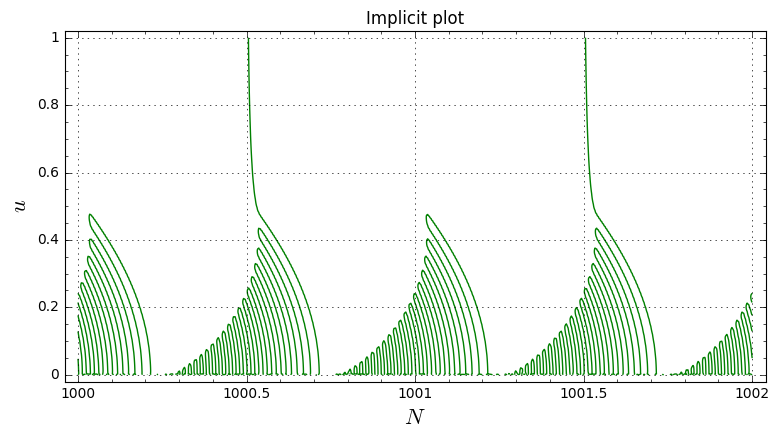Let me play back to ensure I fully understood. I have written 1.18 fully in N, u and capped u at 4 as follows:
Ht118f(N,t) = {
u = if(4*Pi*abs(t)/(4*Pi*N^2)<4,4*Pi*abs(t)/(4*Pi*N^2), 4);
mulfact = exp(Pi^2*(-u*N^2)/64)*(M0((1+I*(4*Pi*N^2))/2))*N^(-(1+I*(4*Pi*N^2))/2)/(8*sqrt(1-I*u/(8*Pi)));
A=mulfact*sum(n=1,1000,exp(-u*(n-N)^2/(4*(1-I*u/(8*Pi)))-2*Pi*I*N^2*log(n/N)));
return(A);
}When I then run the root finding for N[26, 34], t [-3000,-2980], I do get roots at approximately half an integer like these:
-3000.00000000, 26.50506056
-3000.00000000, 27.50506039
-3000.00000000, 28.50646986
-3000.00000000, 29.50802722
-3000.00000000, 30.50974867
-3000.00000000, 31.51165483
-3000.00000000, 32.51377237
-3000.00000000, 33.51613622
-3000.00000000, 34.51879268
-2990.00000000, 26.50506056
-2990.00000000, 27.50513046
-2990.00000000, 28.50655129
-2990.00000000, 29.50812153
-2990.00000000, 30.50985767
-2990.00000000, 31.51178081
-2990.00000000, 32.51391822
-2990.00000000, 33.51630570
-2990.00000000, 34.51899072
-2980.00000000, 26.50506056
-2980.00000000, 27.50520138
-2980.00000000, 28.50663372
-2980.00000000, 29.50821699
-2980.00000000, 30.50996805
-2980.00000000, 31.51190842
-2980.00000000, 32.51406604
-2980.00000000, 33.51647757
-2980.00000000, 34.51919170The same, but now for N[100, 110], t [-3000,-2980]
-3000.00000000, 100.42704250
-3000.00000000, 101.42812900
-3000.00000000, 102.42922063
-3000.00000000, 103.43031384
-3000.00000000, 104.43140573
-3000.00000000, 105.49725631
-3000.00000000, 106.43357639
-3000.00000000, 107.99954423
-3000.00000000, 109.17267055
-3000.00000000, 110.17303455
-2990.00000000, 100.42706678
-2990.00000000, 101.42815533
-2990.00000000, 102.42924850
-2990.00000000, 103.43034285
-2990.00000000, 104.43143553
-2990.00000000, 105.49729523
-2990.00000000, 106.43360700
-2990.00000000, 107.99958021
-2990.00000000, 109.17270673
-2990.00000000, 110.17306971
-2980.00000000, 100.42709133
-2980.00000000, 101.42818186
-2980.00000000, 102.42927653
-2980.00000000, 103.43037196
-2980.00000000, 104.43146540
-2980.00000000, 105.49733403
-2980.00000000, 106.43363763
-2980.00000000, 107.99961606
-2980.00000000, 109.17274278
-2980.00000000, 110.17310474No longer at the half integer, but the vertical line pattern clearly remains.
EDIT: and for N[10000, 10010], t [-3000,-2980]. Seems that rationals are preferred.
-3000.00000000, 10001.74999702
-3000.00000000, 10004.99999730
-3000.00000000, 10005.12499807
-3000.00000000, 10009.40234201
-3000.00000000, 10010.99999869
-2990.00000000, 10001.74999702
-2990.00000000, 10004.99999731
-2990.00000000, 10005.12499808
-2990.00000000, 10009.40234201
-2990.00000000, 10010.99999867
-2980.00000000, 10001.74999703
-2980.00000000, 10004.99999733
-2980.00000000, 10005.12499808
-2980.00000000, 10009.40234200
-2980.00000000, 10010.99999865Before I run any plots, is this what you are after?





























 A multiplier has been normalized for this plot.
A multiplier has been normalized for this plot.

Grateful for any help to properly evaluate the sequence of equations on this Wiki page: http://michaelnielsen.org/polymath1/index.php?title=Polymath15_test_problem#Large_negative_values_of_.5Bmath.5Dt.5B.2Fmath.5D
Below is the pari/gp code I have used so far. At the end of the code is a simple rootfinder that should (approximately) find this sequence of roots:
however from eq 318 onwards it finds many more roots (also at different t, e.g. -100). Have experimented with the integral limits, the integral's fixed parameter, the real precision settings of pari and the size of the sums, but no success yet.
Have re-injected some of the non-zero multiplication factors that can be switched on/off if needed.
One thing I noticed is that after eq 307 the function doesn't seem to be real anymore (see data at the end). Not sure if this should matter though, since I use the real value of Ht for root finding.